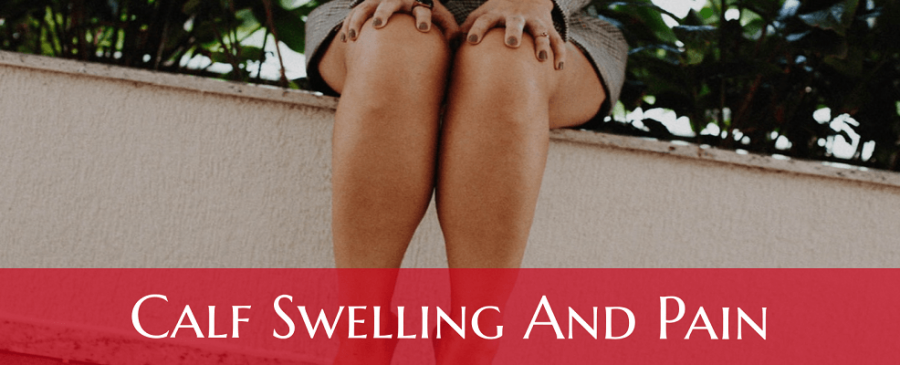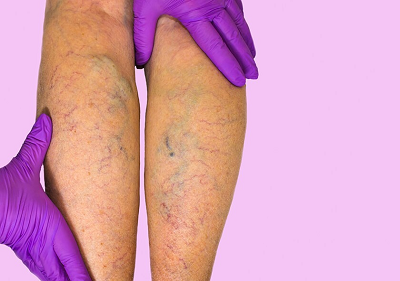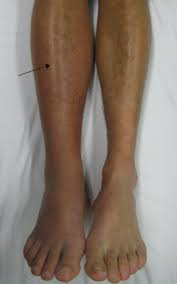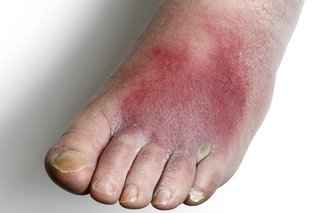Calf Swelling and Pain: (Right or Left Side): Causes, Treatment

Last updated on July 26th, 2018 at 04:46 pm
Question: What causes left or right calf swelling with tightness? Are there available treatment options?
Having to deal with pain or swelling of any part of your body can be disturbing; And you quickly want to know why its happening.
If you’ve developed calf swelling on one leg, it is important you see you doctor to determine the cause. The truth is, Calf swelling may not be due to a serious health concern; And if you are lucky it could happen as a result of not stretching before a workout. Other non-serious causes of calf swelling are dehydration and high-intensity exercises.
Having said that, right or left calf swelling can be due to serious medical issues. In fact, in some cases, it may cause sudden death.
If you experience swelling of both calf muscle, it means you have a systemic illness. Swelling can affect other parts of your body, extending below your knees down to your ankle. On the other hand, if swelling only affects one calf muscle, it is a localized condition.
Serious causes of calf swelling and tightness are cellulitis, direct trauma to your calf, injury to the gastrocnemius and soleus muscle, lymphedema, chronic venous insufficiency, and deep venous thrombosis (DVT).
While calf swelling may not always be life-threatening, sudden death may occur if a clot dislodges and moves to your lungs. So, it is best you see a doctor.
Here are some questions your doctor will ask you
Duration of calf muscle pain;
- It is important you identify how long swelling in your calf is lasting now
Location of swelling;
- Is it just one calf muscle that is affected?
- Do you feel pain and swelling on the other leg?
- Did swelling extend to the ankles and foot?
Other questions;
- Are there any color changes of the overlying skin?
- Do you have an ulcer on the affected leg too?
- Do you feel difficulty in breathing when walking or on activity?
- Any chest pain, fever or a headache?
- Do calf swelling worsen after walking, running, sitting or standing for too long?
This article explains why you have swelling of the calf muscle with or without pain, and treatment options.
What causes left or right Calf swelling?
If you have swelling affecting the left or right side of your calf muscle, it is important you see your doctor.
While mild pain and swelling may go away, it is vital you allow your doctor to determine the underlying cause. In some instance, a deep venous thrombosis, which can result in death may be asymptomatic.
Here are causes of calf swelling and pain
1. Venous insufficiency
The human body is made up of arteries and veins. In simple terms, the arteries deliver blood and oxygen to your body tissues while the vein returns used deoxygenated blood back from your body tissues to your heart.
Within your vein are valves that ensure one-directional movement of blood against gravity, and contraction of your calf muscles assists venous return.
If there is trauma to the valves in your veins, it can affect blood flow in your veins and result in calf swelling that may extend from your knees to your ankles.
In severe cases, calf swelling may cause an ulcer in the affected limb as blood pools and fails to return.
 Who are at risk of venous insufficiency?
Who are at risk of venous insufficiency?
- Pregnant women
- Women and men that smoke cigarettes
- Previous history of a blood clot
- A family history of the illness. So, if anyone in your family has been affected, you could also have similar problems.
What other symptoms will I experience?
Besides calf and leg swelling, there are other symptoms you may experience. A varicose vein (that is, a long, tortuous and enlarged vein that runs close to the skin), pain, and overlying skin changes of the affected calf due to pooling of blood.
Any treatment options?
Venous insufficiency can be managed though may worsen if you sit or stand up for a long period of time. There are many treatments available, and it is best to see your doctor for diagnosis and treatment.
Compression stocking can be used to add more pressure on your calf to assist in the return of blood to your heart.
2. Deep venous thrombosis (DVT)
A deep vein thrombosis affects about 900,000 people in the United States each year, and a common symptom is swelling of the calf muscle. DVT means a clot develops in your deep veins and mostly affect the legs. In some cases, the clot dislodges and travels to your lungs resulting in life-threatening complications.
 Who is at risk of a DVT?
Who is at risk of a DVT?
A DVT happens to people who are prone to clot formation. Usually, surgery, sitting for too long, and being bedridden due to illness increases the chances for a clot to form. Also, pregnant women are more likely to have a clot than non-pregnant women.
Other risk factors for DVT are obesity, smoking cigarettes, age over 60 years, traveling long distance without a break.
What other symptoms of a DVT?
If you have a clot in the deep veins of your calf, you can experience sweating of the affected calf muscle with pain, redness, cramping, and skin color discoloration.
In severe cases, especially if a clot migrates to your lungs, you will have severe difficulty in breathing, coughing up bloody mucus, chest tightness, and dizziness
How to avoid and treat a DVT?
First of all, if you develop the above-listed symptoms, you should see a doctor ASAP. This is to prevent your clots from growing bigger or migrating to your heart (pulmonary embolism).
Here are simple ways to avoid and treat a DVT
- Take a break while traveling. Sometimes, you may be traveling by air or by road and have no time for body stretching at all. To avoid this, take a break and move around.
- Avoid cigarette smoking
- Take blood thinners or thrombolytic drug (see your doctor before use of these medications as they have serious side effects)
- Quick ambulation after surgery or illness
- Use compression stockings
3. A direct calf muscle injury
Calf injury due to a fall, injury, accident, or penetrating injury will affect muscles of the calf. The calf is made up of the gastrocnemius and soleus muscles. These muscles extend from the knee and attach to the Achilles tendon at your heel.
Trauma to these muscles will cause swelling and pain
4. Cellulitis
Cellulitis may also be the reason you have swelling, pain, and redness localized in one of your legs. If you’ve had surgery, break in your skin, or a penetrating wound on your calf or leg, it could allow staphylococci and streptococcus bacteria to move into your skin resulting in an infection.
Symptoms of cellulitis are redness of the affected leg with swelling that may extend to your calf region.
Other symptoms are pain, hot sensation, and pain while walking.
 If you have the above symptoms, it is important you see your doctor quickly. This is because an untreated skin infection can get complicated forming an abscess (that is, pus inside your leg).
If you have the above symptoms, it is important you see your doctor quickly. This is because an untreated skin infection can get complicated forming an abscess (that is, pus inside your leg).
Treatment options include the use of antibiotics; However, in severe cases where an abscess has occurred, surgery will be needed.
5. Lymphedema
Lymphedema may cause swelling of your leg, calf, or thighs and this happens if your lymphatic system malfunctions.
Ordinarily, your body delivers blood through the arteries and receives used-up blood through your veins. There is another system called the lymphatic system that help move fluid (called lymph) from your tissue to the blood. This movement is made possible because of the presence of valves that ensure one-directional movement of lymph.
Any damage to these valves will affect the lymphatic system resulting in pooling of fluid in your leg, and in severe cases cause disfiguring of the affected limb.
In the United States, women with breast cancer can develop lymphedema during cancer treatment (radiation). Other causes of lymphedema are filariasis.
6. Heart failure
If you experience swelling of both calf muscles that extends to your ankle and feet, it could be during to kidney, liver or heart failure.
Heart failure means your heart is weak and not functioning optimally to pump blood as required. If this happens, fluid moves into your lower extremities affecting your leg and calf.
Depending on the severity of illness, swelling may progress to your thighs and abdomen. Beside painless leg and calf swelling, you may also experience cough, difficulty while breathing, easily fatigued, difficulty sleeping at night, wheezing and a sudden increase in your weight due to fluid accumulation.
What causes Calf swelling after walking
1. Lack of prior warm up and stretching
Before a workout, it is crucial you have a warm-up. This helps to stretch and free up your muscles, make them flexible and also to make your joints free.
If you are experiencing calf swelling after walking, this could be the cause.
2. Dehydration
During exercise, your body naturally loses fluid through sweating. If you don’t hydrate yourself thoroughly, dehydration can set in affecting the muscle of your calf.
Always take in water to stay hydrated.
